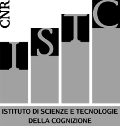SYNOPSIS
Authors: Gianluca Baldassarre, Domenico Parisi, Stefano Nolfi
Topic and its relevance. This is research thread, now terminated, was conducted within the EUfunded project Swarm-bots. Collective robotics involves the use of multiple robots to carry out tasks that could not be carried out by single robots alone. For some tasks, the simplicity of single robots in terms of sensors, actuators, and communication capabilities can give robustness and low-cost to the whole ``swarm'' of robots. In this cases, the coordination between robots, needed to carry out a common task in cooperation, can rely on distributed (vs. centralised/hierarchical) coordination and communication mechanisms typically exploited by social insects (e.g., ants and bees), for example stigmergy (what one robot does with its body and in the environment is directly exploited by the others for coordination).
Questions and goals. What minimal sensors and actuators can robots have to best coordinate in tasks involving colletive navigation on rough terrains? How can their controllers be organised to give rise to an effective distributed emergent coordination? What are the capabilities and properties of the emergent behaviours?
Methods. The project Swarm-bots built relatively simple natigating robots (about 15 cm of diameter) that can navigate on rough terrains with two tracks and have a turning turret that can rotate on the tracks (as a tank) and endowed with a gripper with which the robots can be attached to the turret of other robots. Here we exploited a special sensor, suggested and developped by the coordination opportunities revealed by the simulations, located between the turret and the truks and that can sense the direction and intensity with which a robot is pulled by other robots attached to its turret. We used these robots, both simulated and real, to form groups of robots permanently attached between them (4 to 8). The robot groups were tested in tasks where they had to freely explore a (possibly rough) open field, or mazes in search of a light target. The controller was a simple neural network getting as input the direction of pulling of the companion robots and returning as output the speed of motion of the two robot's tracks. The controller's parameters (connection weights of the network) were evolved with a genetic algorithm using as fitness the speed of motion of the whole group in any direction, and, when present, towards the light target. Importantly, the individual of the genetic algorithm was one robot controller that was then copied without changes into all the robots of a robot team: this mimics the similarity of DNA of the members of a colony of social insects (``group selection'').
Results. The resuls show that the genetic algorithm leads to the emergence of a controller for which the robots tend to move fast when pulled from behind by others, but also to turn left or right when they are pulled from the left or the right hand side (conformist behaviour). This behaviour gives rise to a fast coordination between the robots so that they rapidly agree on a common emergent direction of motion. This behaviour also allows the group to change direction of motion when they encounter an obstacle, and can easily be biased by the perception of a litght-target to move to it. Results also show that the emerged coordination mechanism leads to an suddent abrupt increase of coordination: a measure of the entropy of the group direction reveals how this resembles a phase transition typical of collective physical systems.
Conclusions. The research has shown how simple robots endowed with simple controllers can acquire, by evolution, very effective and sophisticated behaviours if these can rely upon stigmergic sensors and mechanisms exploiting self-organisation.

